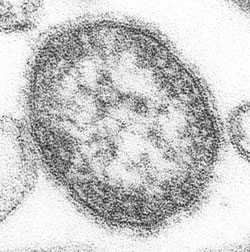 |
| The measles virus--Courtesy of CDC, public domain |
In the decade after the U.S. eliminated indigenous measles, the country experienced few cases of the disease. This began to change in 2011 when the U.S. suffered a spate of outbreaks. While most of the disease clusters were small, Centers for Disease Control and Prevention (CDC) staffers estimate the cost of managing them was up to $5.3 million.
The CDC tallied the cost of the 16 outbreaks in a paper published in the current issue of the journal Vaccine. The calculation considered the time and resources local and state public health authorities allocated to manage the 16 outbreaks in the U.S. in 2011. A total of 107 people were infected that year in clusters that ranged from three to 22 cases. The CDC researchers estimate that each infection cost authorities $11,933 to $29,833. A further 113 isolated cases of measles occurred outside of an outbreak situation in 2011.
The CDC paper shows that management of these clusters and isolated cases requires significant investment from health authorities. And each dollar spent on measles has to be diverted from another area of public health. "Beyond the impact on local and state public health departments, responses to measles outbreaks also affect hospitals, clinics, as well as non-health public departments such as schools, universities and occasionally local police departments enforcing quarantines," the authors wrote.
Some of the costs associated with managing even a potential measles outbreak were shown by events in California this week. Health authorities issued a warning after discovering a student at the University of California, Berkeley, had contracted measles. The student could have infected fellow students and travelers on trains. "Measles is a very serious viral illness and it is very contagious," local communicable disease program director Erika Jenssen said at a media event attended by CNN.
- here's the Vaccine paper
- read the CNN article